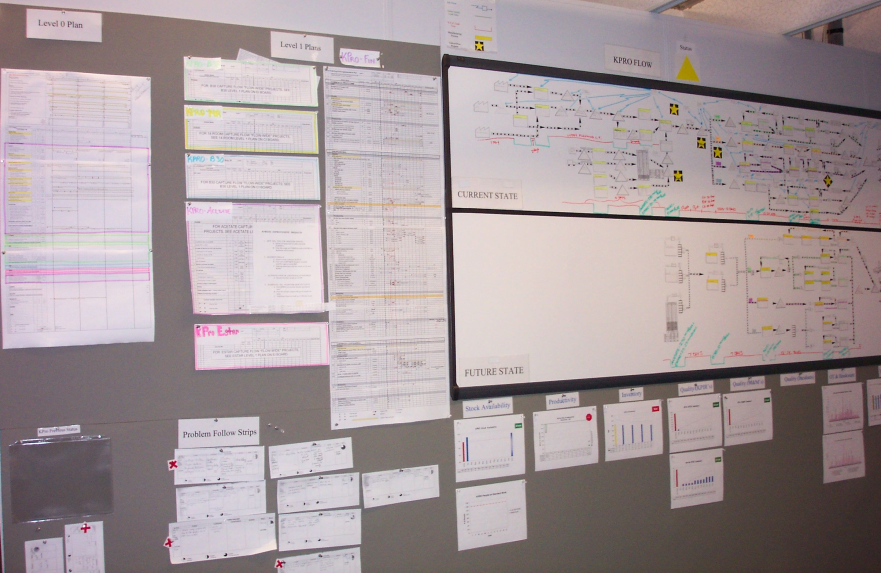Thanks to everyone who left comments on the last post, Learning to See in 2023. You are making me think.
Although Learning to See (the book) describes building your value stream map on A3 / 11×17 paper, most of the maps I have seen have been large affairs on a wall.

I like this approach because it shifts people into the position of standing side-by-side talking about what is in front of them, which fosters collaboration.
The question in the title, though, is more about whose wall is it? Who sees this every day, who is standing and talking about the current state, the future state, and steps to close the gap between them?
I usually see these in the Continuous Improvement team’s workspace. That was certainly the case for the one in the photo. Sometimes they would bring management into that room to discuss progress, but all too often that became a report-out to the managers.
And right there we have an interesting situation: The Continuous Improvement Director and his team have a much deeper understanding of what was going on than the people in charge.
This was partly because it was the Continuous Improvement team members who made these maps in the first place. And they were the ones tracking the metrics, including quality, productivity. They were the ones identifying the problems, and they were the ones working to solve the problems.
And they were the ones complaining when things eroded because management “wasn’t supporting the changes.”
What’s the problem here? What were they actually expecting the line leaders to do?
As a Continuous Improvement team (and if you are reading this, that is likely you), your ultimate goal is to enable the line leaders by engaging through them rather than engaging for them.
You likely have to get there step-by-step, with successive target conditions, but it is the level of engagement of those leaders, and their growing competency in doing so that you and your C.I. team should be tracking on your walls.
Think about what that would look like.
I’ve resonated deeply with this post and the Learning to See post. As a former performance improvement consultant, now administrator in a teaching hospital, I find it helpful to have a consultant work with us to problem solve because they can be a neutral source when going through the process. Sometimes, we are too close to the problem, or as I like to say, we are in the bag and cannot get out of the bag. I think it is crucial to build a workforce that is capable of problem solving so they have some ownership, can improve upon the work they do, and are engaged in meaningful work. I do agree with the bottom line, leaders need to own the work in order for it to make meaningful change and to sustain the gains! Thank you!!
I LOVE THIS!!
Hi Mark
We keep our current VSM/VSD documents posted at the gemba on the line. They are created by the line team members and the supervisors. Us as CI, we only facilitate the mapping creation event. We usually get 3-4 improvement charters written from each mapping and that is done by the process owner and an assigned project manager from that team. Us as CI we only facilitate this happening so the business truly owns.
Dan –
Perfect!
If the maps are not facilitating a pretty much continuous conversation about the next step(s) toward the future state, then they are no more than wallpaper.
I am happy to see your organization understands this. 🙂
In my current org. VSMs don’t really resonate with the business. There are other existing methods that serve a similar function so I create a VSM but translate and communicate it in other ways. I feel like this forces me to clarify the principles behind a tool and then flex on the delivery.
Ted –
That’s a really good point: The VSM isn’t canon, it is just a way to grasp the current condition at flow level, and a way to express the future state / target state, whatever we want to call it.
It is far more important for the line leaders to have a way to arrive at a common, shared, truth that they can talk to.